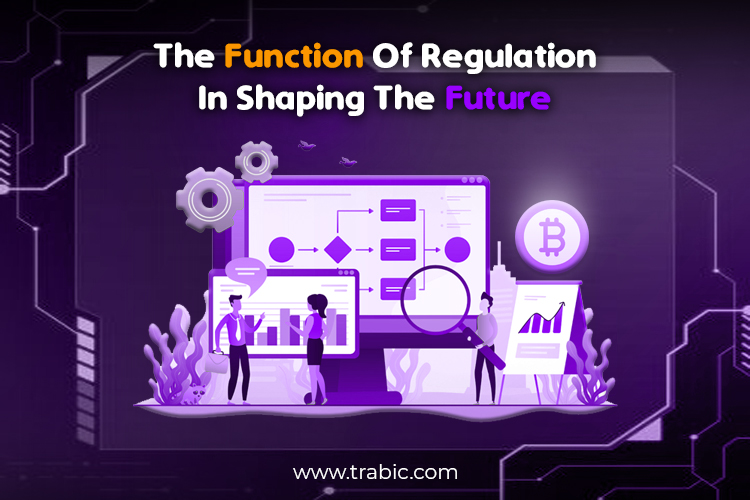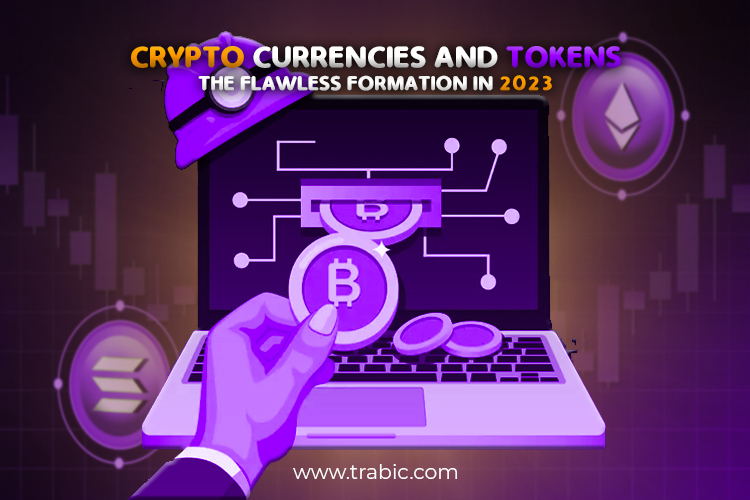In recent years, the world has seen a tremendous surge in the popularity of cryptocurrencies and tokens. These digital assets have revolutionized the way we think about money and finance. As we enter 2023, the formation of cryptocurrencies and tokens continues to evolve rapidly, presenting new opportunities and challenges. In this blog post, we will explore the fascinating world of cryptocurrencies and tokens, exploring their formation and uncovering the trends shaping the landscape.
The Rise of Crypto Currencies and Tokens
The birth of Bitcoin in 2009 was the advent of a renewed era in finance. Since then, cryptocurrencies and tokens have gained significant traction, captivating the attention of individuals, investors, and institutions worldwide. These digital assets operate on the foundation of blockchain technology, a decentralized and transparent system that enables secure transactions and eliminates the need for intermediaries. Cryptocurrencies, such as Bitcoin and Ethereum, serve as digital money, offering a decentralized alternative to traditional fiat currencies.
On the other hand, Tokens represent digital assets or utilities within a specific blockchain ecosystem. They can be utilized for diverse objectives, including fundraising through Initial Coin Offerings (ICOs) and powering decentralized applications (DApps). The formation process of cryptocurrencies and tokens is rooted in the principles of blockchain technology.
Blockchain acts as a distributed ledger, recording all transactions across a network of computers. This technology ensures transparency, immutability, and security, making it an ideal platform for creating and circulating digital assets. In recent years, the formation of cryptocurrencies and tokens has expanded beyond digital money.
Non-fungible tokens (NFTs) have gained immense popularity, enabling the right and trading of individual digital assets, such as artwork, collectibles, and virtual real estate. This new wave of digital ownership has opened up exciting possibilities for creators, artists, and investors. As the popularity of cryptocurrencies and tokens continues to soar, governments and regulatory bodies grapple with the need to establish clear guidelines and frameworks.
Regulatory efforts aim to balance fostering innovation and protecting investors from fraudulent activities and scams. The evolving regulatory landscape significantly impacts the formation and development of crypto assets, shaping the industry’s trajectory in the coming years. In this blog post, we will explore the formation process of cryptocurrencies and tokens, shedding light on the underlying technology, regulatory challenges, emerging trends, and potential opportunities.
By understanding the dynamics and possibilities within this evolving landscape, readers will be equipped with the knowledge to navigate the exciting world of digital finance in 2023 and beyond. Stay tuned as we uncover the secrets behind the formation of cryptocurrencies and tokens, unlocking the potential of this digital revolution.
Understanding the Formation Process
The formation process of cryptocurrencies and tokens is rooted in the principles of blockchain technology. Blockchain, often defined as a distributed ledger, is a decentralized and transparent system that enables secure transactions and eliminates the need for intermediaries. At the crux of the technology is a network of computers, understood as nodes, that function together to validate and register transactions. These transactions are grouped into blocks and then added to a chain of previous blocks, forming a chronological and immutable record of all transactions.
To create a new cryptocurrency, developers typically start by designing a new blockchain or utilizing an existing one. They define the rules and protocols that govern the currency, including its supply, transaction speed, and consensus mechanism. Consensus mechanisms play a crucial role in ensuring the integrity of the blockchain and preventing fraudulent activities.

The most well-known consensus mechanism is Proof of Work (PoW), which requires participants, known as miners, to decipher complicated mathematical problems to validate dealings and add blocks to the chain. Another popular consensus mechanism is Proof of Stake (PoS), where participants are chosen to validate transactions established on the number of tokens they hold.
Mining or minting typically introduces the new cryptocurrency once the blockchain and consensus mechanism is established. Miners or validators contribute computational power or stake their tokens to secure the network and validate transactions. In return, they are rewarded with just-formed tokens or transaction fees. Tokens, on the other hand, are created within existing blockchain ecosystems. These ecosystems can be public or private and deliver a platform for designers to create decentralized applications (DApps) or utility tokens.
Developers usually deploy self-executing smart contracts with predefined rules and conditions to create and manage tokens. Smart contracts are programmed on blockchain platforms like Ethereum, and they automatically execute transactions and enforce rules without the need for intermediaries. Tokens can serve various purposes within their respective ecosystems. They can represent ownership of assets, enable voting rights, grant access to services or products, or act as an incentive mechanism within decentralized applications.
Understanding the formation process of cryptocurrencies and tokens allows individuals to grasp the technical foundations behind these digital assets. By comprehending concepts such as blockchain, consensus mechanisms, mining, and smart contracts, readers gain insights into the mechanisms that ensure these digital assets’ security, transparency, and functionality.
The Function of Regulation in Shaping the Future
As cryptocurrencies and tokens continue to gain traction, the role of regulation in shaping their formation and development becomes increasingly important. Regulatory frameworks play a crucial role in fostering innovation, protecting investors, and ensuring the stability and integrity of the financial system. One of the primary concerns surrounding cryptocurrencies and tokens is the potential for fraudulent activities, money laundering, and terrorist financing.

Governments and regulatory bodies recognize the need to establish clear guidelines to mitigate these risks and protect consumers. They aim to balance fostering innovation and maintaining financial security by implementing robust regulatory measures. Regulations vary across different jurisdictions, and the approach to crypto assets needs to be more global uniformity.
Some countries have embraced cryptocurrencies and tokens, implementing favorable regulations to attract blockchain-based businesses and promote technological advancements. Others have adopted a more cautious approach, imposing stricter regulations to minimize risks. The regulatory landscape surrounding crypto assets is constantly evolving. Governments increasingly acknowledge the importance of providing clarity and certainty to market participants.
Regulatory initiatives often focus on investor protection, anti-money laundering (AML), know-your-customer (KYC) requirements, and market integrity. One key aspect of regulation is the classification of crypto assets. Some jurisdictions consider them securities, commodities, or a separate asset class. This classification determines the oversight and compliance requirements for issuers and market participants.
The regulation also influences the adoption of crypto assets in traditional financial systems. As regulators establish frameworks for integrating crypto assets into existing financial infrastructures, such as payment systems or stock exchanges, mainstream adoption becomes more feasible. This integration can expand the accessibility and acceptance of cryptocurrencies and tokens among traditional investors and institutions. Furthermore, regulatory efforts aim to clarify tax obligations associated with crypto assets. By establishing guidelines for taxation, governments seek to prevent tax evasion and ensure that individuals and businesses accurately report their crypto-related income and capital gains.
However, striking the right balance between regulation and innovation is delicate. More manageable regulations can stifle technological advancements and hinder the crypto industry’s growth.
Regulators must collaborate with industry participants, experts, and innovators to create effective, fair, and adaptive regulations for the rapidly evolving crypto landscape. The role of rule in shaping the fate of cryptocurrencies and tokens is crucial. Effective regulatory frameworks provide clarity, protect investors, and foster innovation. As governments and regulatory bodies work towards establishing comprehensive guidelines, the industry can continue to evolve securely and transparently. Striking the proper balance between rule and creation will be critical to opening the entire prospect of crypto assets in the global financial system.
Emerging Trends and Opportunities
The world of cryptocurrencies and tokens is a rapidly evolving landscape, constantly presenting new trends and opportunities. As we step into 2023, several exciting developments are shaping the future of digital finance. Exploring these emerging trends and seizing the associated opportunities can be a game-changer for investors, entrepreneurs, and individuals looking to participate in this digital revolution.

Non-Fungible Tokens (NFTs)
Non-Fungible Tokens (NFTs) have gained significant attention and popularity recently. NFTs represent unique digital assets on the blockchain, such as artwork, collectibles, and virtual real estate. These tokens enable creators and artists to monetize their digital creations and provide verifiable ownership to buyers. NFTs offer immense potential for artists, musicians, and content creators to directly connect with their audiences and generate revenue. Additionally, NFTs provide investors with a new asset class for appreciating and trading unique digital assets.
Decentralized Finance (DeFi)
Decentralized Finance (DeFi) has emerged as a disruptive force in crypto. DeFi refers to using blockchain and smart contracts to recreate traditional financial systems, such as lending, borrowing, and trading, in a decentralized and permissionless manner. The growth of DeFi platforms has unlocked new opportunities for individuals to participate in financial activities without depending on intermediaries like banks or brokerage firms. Investors can gain interest in their crypto holdings through decentralized lending and borrowing protocols, and traders can engage in decentralized exchanges (DEXs) to trade a wide range of tokens.
Integration with Traditional Finance
Integrating cryptocurrencies and tokens with traditional finance is a significant trend that presents exciting opportunities. Traditional financial institutions are increasingly recognizing the potential of digital assets and exploring ways to incorporate them into their existing infrastructure. Several central banks and financial institutions have started offering custody services for crypto assets, allowing clients to store and manage their digital holdings safely. Moreover, investment firms are launching crypto-focused funds and products, providing investors with exposure to the crypto market through traditional investment vehicles.
Central Bank Digital Currencies (CBDCs)
Central Bank Digital Currencies (CBDCs) have gained traction as governments and central banks explore the potential for digitizing their national currencies. CBDCs aim to provide the benefits of digital currencies, such as faster transactions and increased financial inclusion, while maintaining the stability and control of a centralized authority. Developing and adopting CBDCs could profoundly impact the global financial system, facilitating more efficient cross-border transactions and reshaping the economic landscape. This trend opens up opportunities for businesses and individuals to leverage the benefits of digital currencies while operating within the regulatory frameworks established by central banks.
Enhanced Privacy and Security
Privacy and security are critical considerations in the crypto space. Emerging trends focus on enhancing cryptocurrencies and tokens’ privacy and security features. Technologies like zero-knowledge proofs and privacy-focused blockchains aim to give individuals more significant control over their private data and financial transactions. These enhanced privacy and security measures can foster increased trust and adoption of cryptocurrencies and tokens, attracting individuals and businesses seeking secure and confidential financial transactions.
The emerging trends in the formation of cryptocurrencies and tokens offer many opportunities for investors, entrepreneurs, and individuals. NFTs, DeFi, integration with traditional finance, CBDCs, and enhanced privacy and security are just a few of the tendencies shaping the future of digital finance. By staying informed and actively exploring these trends, individuals can set themselves to take benefit of the exciting opportunities presented by this dynamic and evolving landscape.
Navigating the Risks
While forming cryptocurrencies and tokens presents exciting opportunities, navigating the associated risks effectively is essential. Understanding and addressing these risks can help investors and users make informed decisions and mitigate potential losses. Individuals can navigate the crypto landscape more effectively by understanding and proactively addressing these risks.
Diversifying investments, conducting thorough research, adopting security measures, and staying informed about regulatory developments are vital steps to mitigate risks and make informed decisions in this dynamic and evolving space. Here are some critical dangers to believe when navigating the crypto landscape:
- Volatility: Cryptocurrencies are understood for their high volatility. The value of crypto assets can experience significant fluctuations within short periods. This volatility can result in substantial gains but also lead to substantial losses. It is crucial to carefully consider risk tolerance and invest only what one can afford to lose.
- Security: Security risks are prevalent in the crypto space. Hackers target exchanges, wallets, and individual users to gain unauthorized access and steal crypto assets. Adopting robust security measures, such as using reputable wallets, enabling two-factor authentication, and keeping private keys secure, is essential. Additionally, staying informed about best practices and avoiding suspicious websites or phishing attempts is crucial.
- Regulatory Uncertainty: The regulatory landscape surrounding cryptocurrencies and tokens still evolves and varies across jurisdictions. Regulation changes can impact crypto assets’ legality, trading, and taxation. It is essential to stay updated on regulatory developments and comply with the applicable laws in one’s jurisdiction to avoid legal and financial consequences.
- Market Manipulation: Crypto markets are susceptible to market manipulation. Traders with significant holdings, known as whales, can influence prices using pump-and-dump schemes. It is essential to conduct thorough research, avoid investment schemes promising guaranteed returns, and exercise caution when trading in highly volatile markets.
- Lack of Oversight and Transparency: The decentralized nature of crypto assets means there is often a need for centralized oversight and transparency. Some projects may need more proper due diligence, and fraudulent schemes can exist. It is crucial to research projects thoroughly and evaluates their teams, technology, and community support before investing or participating.
- Operational Risks: Crypto assets rely on the underlying technology, such as blockchain networks. Technical glitches, vulnerabilities, or coding errors can lead to operational risks. It is essential to choose reputable platforms and providers, assess their security measures, and be prepared for potential downtime or technical issues.
- Lack of Investor Protection: Unlike traditional financial systems, crypto assets may have different levels of investor protection mechanisms, such as deposit insurance or regulatory oversight. In case of theft or loss, recovering stolen assets can be challenging. Researching and choosing reputable exchanges and service providers with a track record of security and customer support is advisable.
Conclusion
In conclusion, the formation of cryptocurrencies and tokens in 2023 presents a world of possibilities, but it also arrives with jeopardies that must be navigated carefully. Understanding the underlying technology, emerging trends, and regulatory landscape is crucial for individuals looking to participate in this digital revolution. By exploring the formation process of crypto assets, individuals can gain insights into the technical foundations behind these digital assets. They can also grasp the significance of blockchain technology, consensus mechanisms, and smart contracts in creating and managing cryptocurrencies and tokens.
Furthermore, considering the role of regulation in shaping the future of crypto assets is essential. Regulatory frameworks aim to strike a balance between fostering innovation and protecting investors, and they play a crucial role in providing clarity, stability, and security to the industry.
However, it is essential to acknowledge the risks associated with crypto assets, such as volatility, security vulnerabilities, regulatory uncertainty, and market manipulation. Navigating these risks requires diligence, caution, and a proactive approach to security and compliance. Despite the risks, the emerging trends and opportunities within the crypto landscape are significant.
Non-Fungible Tokens (NFTs), Decentralized Finance (DeFi), integration with traditional finance, Central Bank Digital Currencies (CBDCs), and enhanced privacy and security measures present exciting avenues for investors, entrepreneurs, and individuals to participate in this digital revolution. Ultimately, by staying informed, conducting thorough research, adopting best practices for security, and navigating the risks effectively, individuals can position themselves to leverage the opportunities and be part of the transformative potential that cryptocurrencies and tokens offer in 2023 and beyond.
